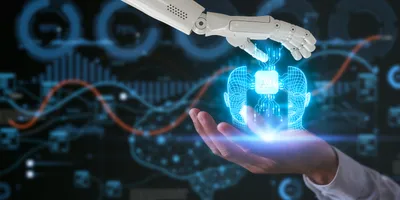AI and automation are no longer concepts for the future—they’re becoming daily tools in the lab. For managers, the question isn’t whether to adopt them, but how to prepare for the next phase: integrating intelligent systems that can learn, act, and adapt alongside your team.
Complementary trends in lab automation and AI—including agentic AI, autonomous mobile robots, and more—are together pointing to how these systems will manifest: a future where closed-loop, autonomous labs may accelerate experimentation and allow scientists to iterate on their research faster than ever before.
Trends and advancements in laboratory AI
Following FAIR (findable, accessible, interoperable, reusable) data principles is important to achieve fewer bottlenecks and more useful analyses in the lab. But FAIR can also serve as the foundation for allowing the lab to innovate in other ways: namely, using artificial intelligence (AI).
De-siloed data for AI model training
Following FAIR data principles naturally leads to de-siloing the data: pulling records from LIMS, ELN, QMS, instruments, standardizing all the data, and consolidating it in a single data lake or data warehouse. De-siloing gives managers a complete view of lab operations and becomes even more powerful when AI models can learn from that unified data.
General-purpose AI models quickly hit the ceiling of their capabilities when trying to use them in a specialized context like lab work. “For AI to be genuinely useful in a research environment, it must reflect the realities of the lab,” says Rob Brown, head of the scientific office at Sapio Sciences. “That means working with domain-specific models that are trained on scientific data and designed to operate within the scientific context.” For lab managers, this shift means investing in data readiness—ensuring clean, consistent datasets before evaluating AI tools. Lab managers should start by applying models to a single workflow, such as instrument maintenance forecasting, before attempting full-scale rollouts. In clinical and pharma labs, especially, evaluating whether AI-generated insights meet validation requirements is critical.
Agentic AI
Have you ever used ChatGPT, Google Gemini, or similar chatbots? These bots are reactive AI models, responding only when prompted by the user. Agentic AI is touted as the proactive evolution of this tech:
“Agentic AI is a class of artificial intelligence that can follow instructions, understand intent, and carry out tasks within a specific scientific or operational context,” Brown says. “Unlike earlier forms of AI that simply respond to queries or generate suggestions, agentic AI is designed to help users take meaningful action towards a goal.” Brown notes that, in a lab environment, these capabilities manifest by interpreting prompts given by the user, retrieving relevant data, applying scientific models to that data, and summarizing results—all without requiring the scientist to manually coordinate systems or pull data.
More autonomous experimentation accelerates science and stretches limited budgets further. When harnessed properly, agentic AI can be an efficiency multiplier with tangible benefits for both research and business. Yet successful implementation requires clarity about which tasks AI agents may automate versus those requiring human sign-off. Lab managers should frame AI as an augmentation tool, not a job replacement, to maintain staff morale and engagement.
Lab Quality Management Certificate
The Lab Quality Management certificate is more than training—it’s a professional advantage.
Gain critical skills and IACET-approved CEUs that make a measurable difference.
One real-world showcase of agentic AI comes from Cedars-Sinai. In a paper published in Bioinformatics, Jason Moore, PhD, chair of the Department of Computational Biomedicine, worked with his lab to create an agentic AI model that referenced “knowledge graphs” of biomedical data to answer various questions posed by the researchers. Moore stated that their agentic AI model provided answers with 80 to 90 percent accuracy, as opposed to the 50 percent accuracy that ChatGPT achieved.
Trends and advancements in laboratory automation
While AI excels in analysis and decision-making, it cannot execute physical tasks on its own. That’s where automation comes in. By connecting instruments through open standards and relieving staff of repetitive manual tasks with mobile robots, automation ensures that the intelligence provided by AI translates into faster, more reliable experimentation.
Open equipment communication protocols
Proprietary communication protocols still limit automation progress, forcing labs to buy equipment from a single vendor to achieve compatibility. There is little to no cross-vendor interoperability, with each vendor forming their own walled garden of equipment. Consequently, it becomes difficult for labs to implement more advanced automated workflows unless all their equipment is from the same vendor (and are all new enough to support the communication protocols at all). Few labs are outfitted this way.
Slowly but surely, however, the tides are changing. Open-source connectivity standards like SiLA 2, as well as standardized data formats like the Allotrope Framework, are “gradually improving plug-and-play integration and data portability,” says Meghav Verma, VP of automation at Axle Informatics. “We’re not there yet, but vendor support and open-source control layers. . .have meaningfully lowered the integration efforts for mixed vendor cells.” While adoption of these standards remains uneven across different types of devices, progress is being made.
As open interfaces mature, lab managers can make purchasing decisions based on performance and budget, not vendor lock-in. They should prioritize vendor interoperability in purchasing decisions, involve IT early for data infrastructure planning, and budget for middleware or integration layers between different platforms.
Autonomous mobile robots
Even when instruments connect digitally, physical sample movement still slows workflows. Whenever a batch of samples is prepped or an analysis is complete, scientists must step away from what they’re currently doing and move the samples to the next asset in the workflow. While moving samples is a quick task, doing so dozens of times per day can add up. Another emerging trend in lab automation—autonomous mobile robots (AMRs)—may be able to streamline sample transfers.
“AMRs are moving plates, consumables, and samples between instruments and rooms—closing the gap between otherwise well-automated islands,” says Verma. Clinical labs have led the adoption of AMRs, but research labs are following their lead.
AMRs and open communication protocols can work in concert to maximize lab automation, negating the need to manually move both physical samples and digital data between assets. Automating these tasks saves time and reduces human error, helping ensure experimental integrity.
For enterprising lab managers looking to incorporate AMRs in their lab, they must factor in recurring maintenance costs, training, and other secondary costs into the ROI assessment. Additionally, identifying the bottlenecks where AMRs would offer maximum payoff from the start, and adapting workflows and safety guidelines would minimize safety risk.
Closed-loop labs: The convergence of AI and automation trends
The four trends outlined above collectively point toward a single destination: the closed-loop laboratory.
A closed-loop lab is one where experimentation, analysis, and iteration happen seamlessly, with minimal human intervention in the routine tasks that slow down progress. Data flows across instruments, software, and processes; AI models generate insights and recommend actions; and automation carries out tasks. Everything is overseen by human experts, but they are left free to pursue the aspects of research that require a uniquely human touch.
Such a paradigm shift may be closer than you think. As Garrett Peterson, chief strategy officer at Yahara Software, says: “While the idea of fully automated, closed-loop laboratories can sound like a radical shift, the underlying principle has been around in lab informatics for some time. At its core, it’s about integrating data and workflows across LIMS, QMS, ERP, instruments, and human-driven steps so that experimentation, analysis, and iteration can happen much more fluidly. Done well, this enables ‘hyper-acceleration’ of discovery through rapid, top-to-bottom process iteration.”
In fact, there are already existing examples. Lawrence Berkeley National Laboratory announced the A-Lab in April 2023, describing it as a closed-loop, automated materials discovery lab powered by robots and AI. The A-Lab can process up to 100 times as many samples as a human can and pare down paths for further investigation with AI. Gerbrand Ceder, PhD, principal investigator for the A-Lab, said that it’s intended to “iterate rapidly, the way scientists operate” while leaving scientists free to spend more time designing experiments.
Similarly, Oak Ridge National Laboratory’s INTERSECT project (Interconnected Science Ecosystem Initiative) uses open architecture to align hardware and software, bringing together agentic AI, AMRs, and robotic systems to enable autonomous laboratories. INTERSECT labs are already running at ORNL, accelerating advances in materials science and chemistry.
The A-Lab and INTERSECT prove what’s possible—but for most labs, the next step is simpler: unifying data, testing targeted AI use cases, and building automation one workflow at a time.














